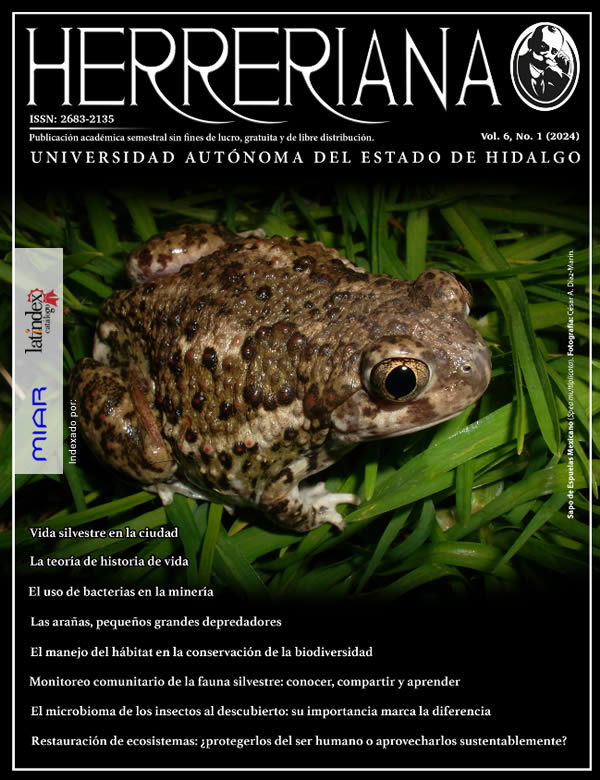Wildlife in the city
(Species inhabiting cities in Central East Mexico)
DOI:
https://doi.org/10.29057/h.v6i1.11789Keywords:
urbanism, sustainability, urban biologic conservation, green cities, city biologic preservationAbstract
Human spatial concentration determines a process known as urbanization. Urbanization affects wildlife as it develops on sites originally used by it. Despite such an effect, today many basic data are unknow, as well the identity of the species using urbanized places. Considering it, here we defined groups and species of wildlife found in urban places of Central East of Mexico, using as working example to Pachuca City. We found reported at least 1735 species, among plants, fungi, amphibians, reptiles, birds, mammals, and microorganisms. As such biodiversity is threatened and is similar in neighboring sites, we suggest ways to preserve it.
Downloads
Publication Facts
Reviewer profiles N/A
Author statements
Indexed in
- Academic society
- N/A
- Publisher
- Universidad Autónoma del Estado de Hidalgo
References
Barnosky AD, N Matzke, S Tomiya, GO Wogan, B Swartz, TB Quental, C Marshall, JL McGuire, EL Lindsey, KC Maguire (2011) Has the Earth's sixth mass extinction already arrived? Nature 471(7336):51-57.
Berlanga H, H Gómez de Silva, VM Vargas-Canales, V Rodríguez-Contreras, LA Sánchez-González, R Ortega-Álvarez, R Calderón-Parra (2015) Aves de México: lista actualizada de especies y nombres comunes.Disponible en: https://www.researchgate.net/publication/292193192_Aves_de_Mexico_lista_actualizada_de_especies_y_nombres_comunes. México D.F. CONABIO, NABCI.
Chace JF, JJ Walsh (2006) Urban effects on native avifauna: a review. Landscape and Urban Planning 74(1):46-69.
CONABIO (2023) EncicloVida. In: Biodiversidad C.N.p.e.C.y.U.d.l., editor. p. https://enciclovida.mx.
Doherty TS, CR Dickman, AS Glen, TM Newsome, DG Nimmo, EG Ritchie, AT Vanak, AJ Wirsing (2017) The global impacts of domestic dogs on threatened vertebrates. Biological Conservation 210:56-59.
Liner E, G Casas-Andreu (2008) Nombres estándar en español, en inglés y nombres científicos de los anfibios y reptiles de México. Society for the Study of Amphibians and Reptiles.
Loss SR, T Will, PP Marra (2013) The impact of free-ranging domestic cats on wildlife of the United States. Nature Communications 4(1):1396.
Merrick R, M Cole, R Pitt, Q Enayat, Z Ivanov, M Day, S Sun, K Sinka, N Woodford, H Mohammed (2022) Antimicrobial-resistant gonorrhoea: the national public health response, England, 2013 to 2020. Eurosurveillance 27(40):2200057.
Mora C, DP Tittensor, S Adl, AGB Simpson, B Worm (2011) How Many Species Are There on Earth and in the Ocean? PLoS Biology 9(8):e1001127.
Pavón NP, M Meza (2009) Cambio climpatico en el Estado de Hidalgo, clasificación y tendencias climáticas. Pachuca, Hidalgo, México. Universidad Autónoma del Estado de Hidalgo. 168 p.
Pérez-Jaramillo E (2017) Diversidad de mariposas (Lepidoptera: Rhopalocera) en un gradiente de urbanización en la zona metropolitana de Pachuca, Hidalgo, México.
Pérez-Pech WA, R Guidetti, A Anguas-Escalante, L Cutz-Pool, A Blanco-Piñón (2017) Primer registro genérico de tardígrados para Pachuca Hidalgo, México y áreas circundantes. Entomología Mexicana 4:688-694.
Pimentel J (2017) Redes de interacción entre abejas y plantas en zonas con diferente nivel de urbanización en el área metropolitana de Pachuca. Universidad Autónoma del estado de Hidalgo. Pachuca, Hidalgo, México.
Ramírez-Bautista A, CA Díaz-Marín, A García-Rosales, C Berriozabal-Islas (2023) ¿Atrapados, sin salida?: El caso de los anfibios y reptiles en la ciudad de Pachuca, Hidalgo, México. Biología y Sociedad 6(11):34-41.
Rivera-Córdova A (2021) Relación densidad y pobreza con casos confirmados por coronavirus en la región metropolitana. Revista Médica Clínica Las Condes 32:81–91.
Romo MA, R Ortiz-Pulido (2022) Análisis de los efectos de la urbanización en la composición, abundancia y distribución de comunidades de aves como una herramienta para la conservación. in Memoria de los trabajos de investigación IV. Pachuca, Hidalgo, México. Universidad Autónoma del Estado de Hidalgo.
SSA (2023) Boletín Epidemiológico México: Sistema Nacional de Vigilancia Epidemiológica. Secretaría de Salud, Gobierno de México. Ciudad de México. Ciudad de México. Secretaría de Salud, Gobierno de México.
Vlahov D, S Galea (2002) Urbanization, urbanicity, and health. Journal of Urban Health 79(1):S1-S12.
Weeks JR (2010) Defining Urban Areas. 33-45 p. in Rashed T., Jürgens C., editors. Remote Sensing of Urban and Suburban Areas. Dordrecht. Springer Netherlands.
Zuria I, AM Olvera-Ramírez, P Ramirez (2019) Manual de técnicas para el estudio de Fauna Nativa en ambientes urbanos. Querétaro, México. REFAMA, Universidad Autónoma de Queretaro.


















